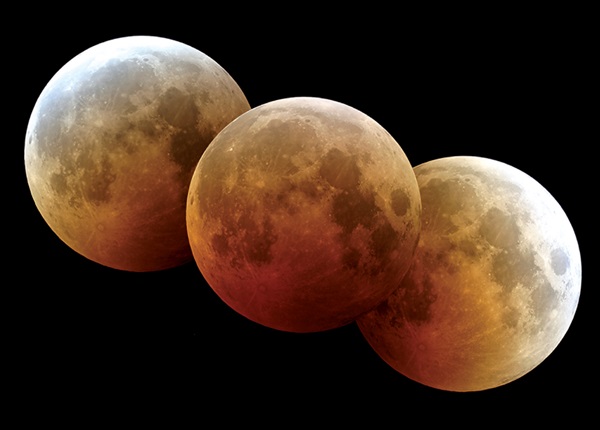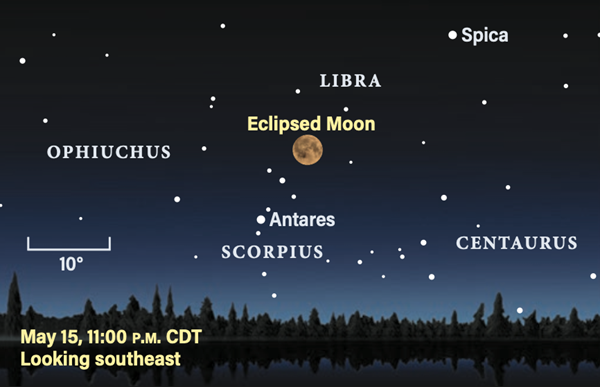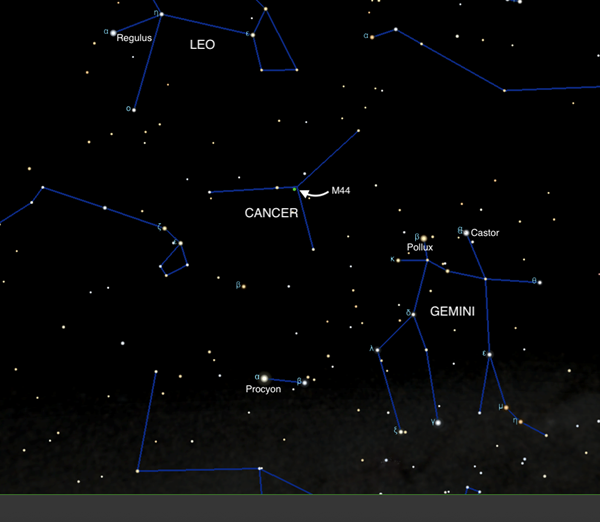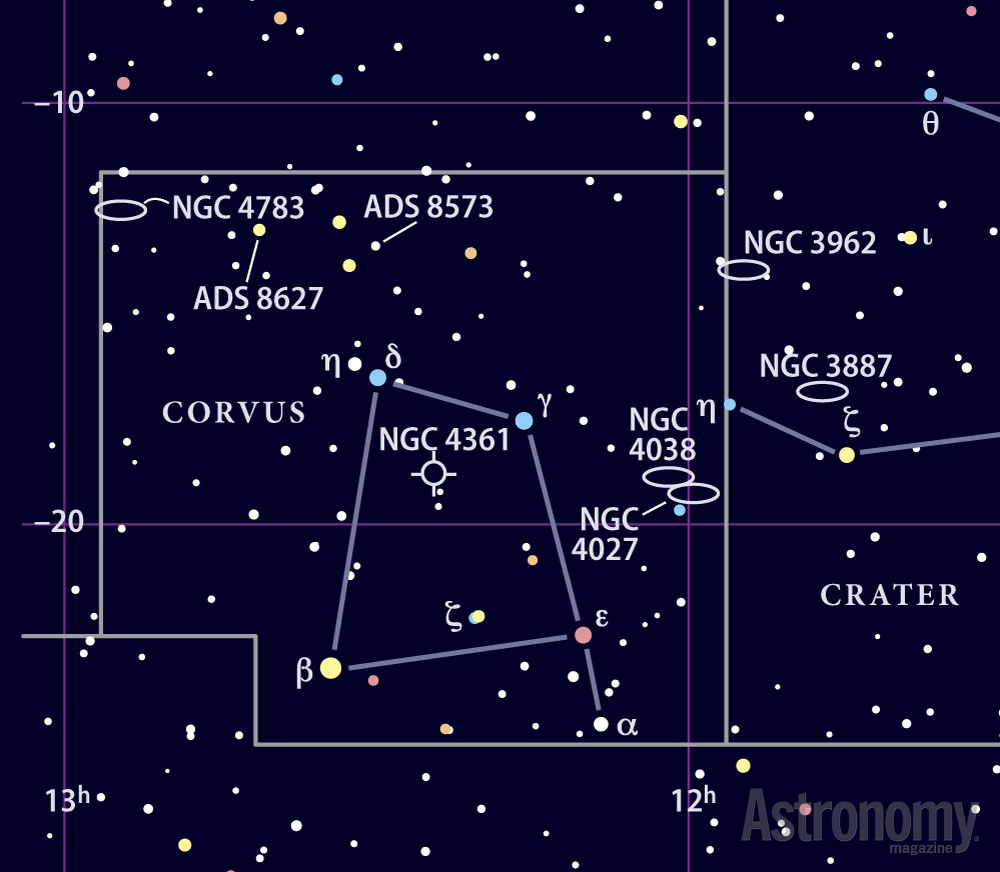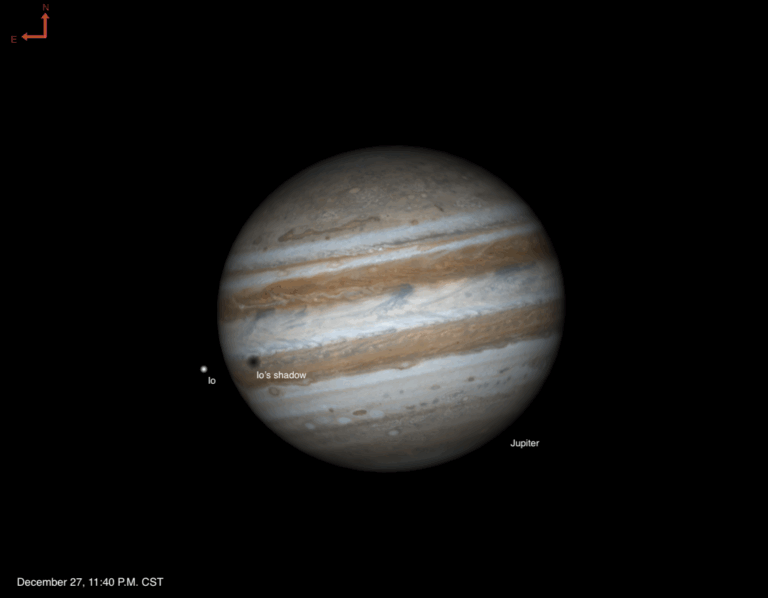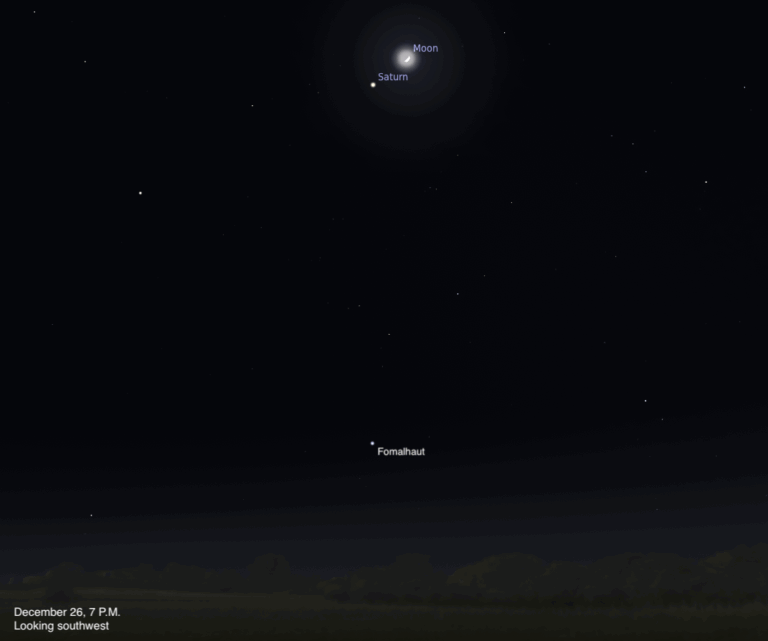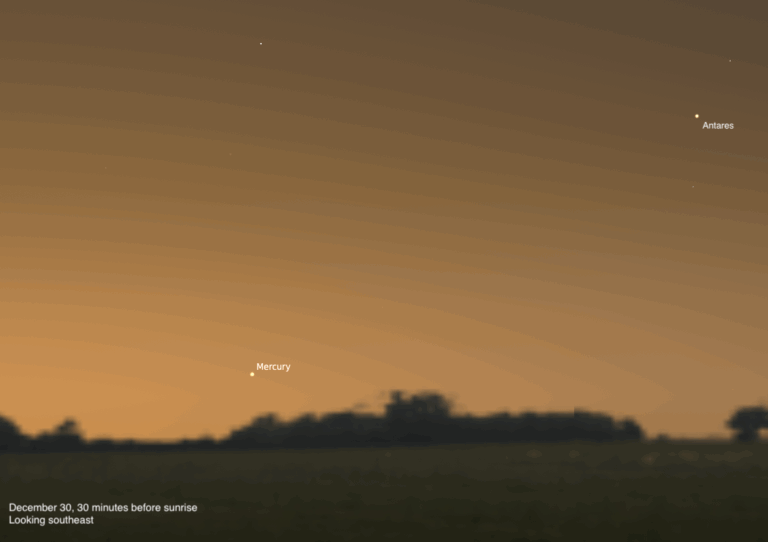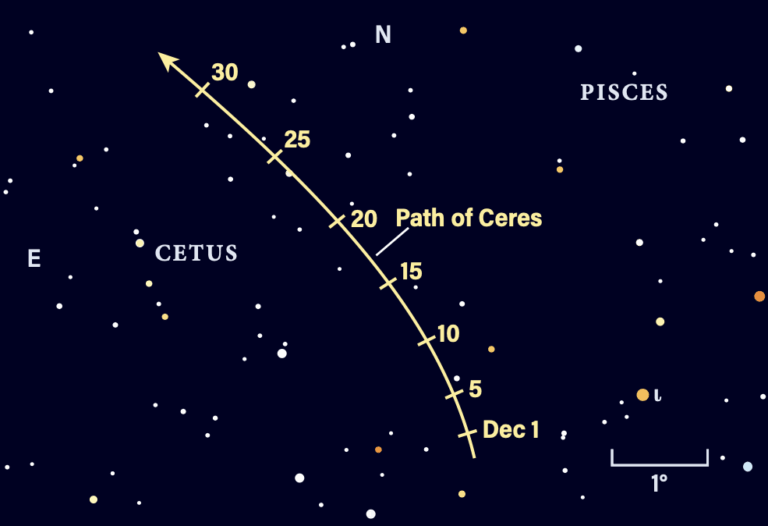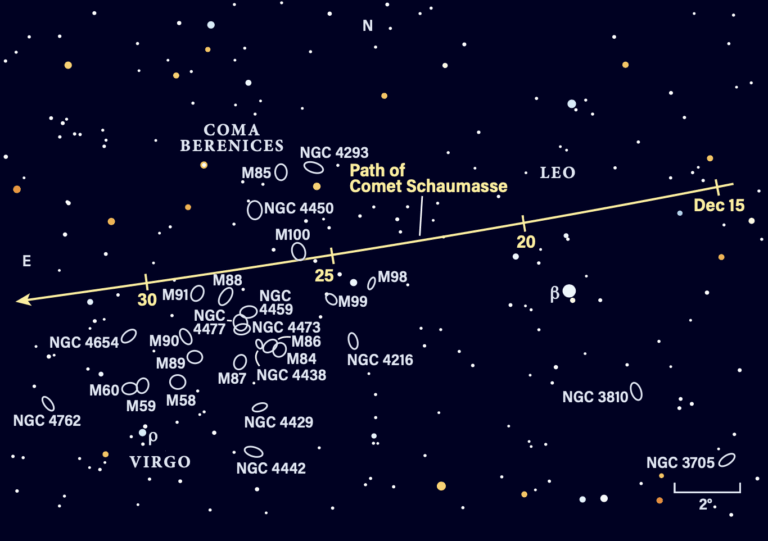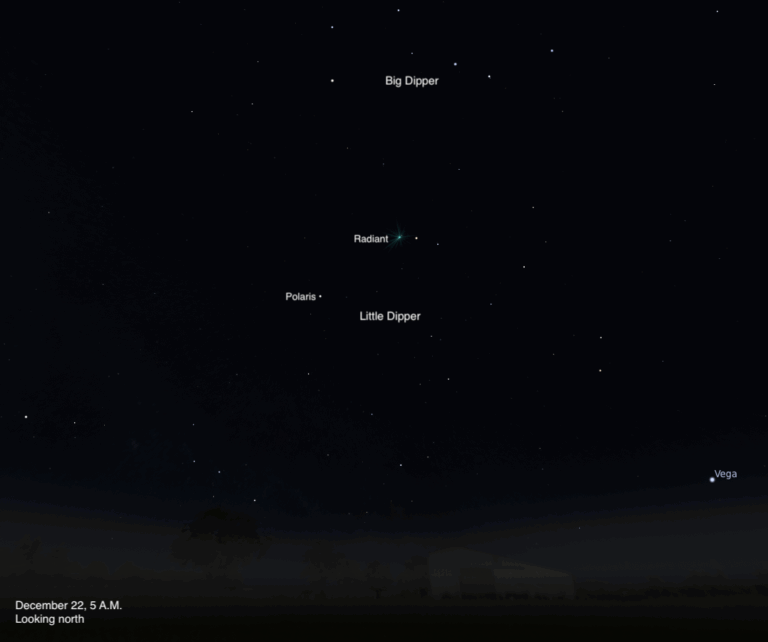Key Takeaways:
Friday, May 13
Enjoy Friday the 13th with an object pulled from Astronomy columnist Stephen James O’Meara’s Ghost Hunt. Although this fun challenge is meant for the Halloween season, plenty of objects on the list are visible in the springtime sky as well. Tonight, the light of the Moon will wash out many fainter targets, but NGC 457 is a 6th-magnitude open cluster in Cassiopeia still visible for those with a telescope.
NGC 457 is also called the Owl Cluster or the E.T. Cluster (among many other names) because its stars form the shape of an owl with its wings spread in flight — or, for those who want that slightly spookier vibe, a familiar Spielberg alien with his arms outstretched.
The cluster sits just over 2° due south of Ruchbah (Delta [δ] Cassiopeiae), the second star from the left in and the leftmost dip in the Queen’s “w” when seen right-side-up. You’ll notice two brighter stars amid a smattering of fainter ones — those bright stars are the figure’s eyes, which can guide you to find the rest of the body, stretching to the northwest. Overall, NGC 457 is home to some two dozen stars brighter than 12th magnitude. A 4-inch scope and magnification of 50x will show 75 cluster stars under good conditions, though you may see fewer due to the bright background tonight. As the Sun is setting, Cassiopeia is swinging down toward the horizon as it circles the North Celestial Pole; the later you stay out, the higher it will eventually climb in the sky, offering even better views as the night goes on.
If this wasn’t spooky enough for you, don’t worry — there’s a stunning total lunar eclipse, also known as a Blood Moon, coming up in just two days’ time.
Sunrise: 5:47 A.M.
Sunset: 8:07 P.M.
Moonrise: 5:24 P.M.
Moonset: 4:25 A.M.
Moon Phase: Waxing gibbous (92%)
*Times for sunrise, sunset, moonrise, and moonset are given in local time from 40° N 90° W. The Moon’s illumination is given at 12 P.M. local time from the same location.
Saturday, May 14
Despite the bright waxing Moon in the sky, tonight is still the night for intrepid comet chasers — especially those versed in astrophotography.
According to the Comet Observation database (COBS), Comet C/2017 K2 (PanSTARRS) O3 is currently at mid-9th magnitude. But K2 also currently sits in far eastern Ophiuchus, which is close to the Moon tonight. Although the comet is bright enough to normally spot visually with large binoculars or a small scope, you may need a larger telescope (6 inches or more) tonight or the benefit of a long photographic exposure to cancel out our satellite’s light. You’ll find K2 about 2.5° northwest of 7th-magnitude open cluster NGC 6709 or, for a brighter signpost, just over 8.5° due east of magnitude 3.7 72 Ophiuchi.
COBS observations indicate K2 is currently brightening as it approaches the Sun for a December perihelion. It’s likely to get at least 1 magnitude brighter still in that time. We’ll keep an eye on this one, for sure!
Sunrise: 5:46 A.M.
Sunset: 8:08 P.M.
Moonrise: 6:37 P.M.
Moonset: 4:52 A.M.
Moon Phase: Waxing gibbous (97%)
Sunday, May 15
Tonight is the night: Experience the first of 2022’s two total lunar eclipses with a Super Flower Blood Moon.
That’s quite a mouthful, so let’s break it down. During a lunar eclipse, the Moon turns an orangey-red as it passes through Earth’s shadow. Hence, media outlets like to call it a Blood Moon — certainly an evocative term! Next, May’s Full Moon is also called the Flower Moon. Technically, the Moon won’t be officially Full until just after midnight (so, early on the morning of the 16th), but the eclipse is long enough that it will stretch well into the 16th, so we’re in the clear. And finally, a Super Moon occurs when the Moon is Full at or around the time it reaches perigee, or the closest point to Earth in its not-quite-circular orbit. That will occur just before noon EDT on the 17th, so within 36 hours of official Full Moon, still close enough to count. It also means the Moon will span nearly 33′ on the sky during the eclipse — slightly larger than its average of 30′ to 31′.
Now that we’ve gotten the name out of the way, what can you expect from this event? The eclipse occurs simultaneously everywehre, so what you see will depend on your location (i.e., the times of local sunset and moonrise). Note that the times we give in this column each week are for observers in the Midwest at a location of 40° N 90° W. Only observers on the East Coast will see the entire eclipse from start to finish in a dark sky; farther west, the Moon will rise with varying stages of the eclipse already underway and progressing as twilight darkens into night.
The eclipse begins at 9:32 P.M. EDT, when the Moon first moves into Earth’s penumbral, or outer, shadow. This should appear as a barely visible darker shading in the lunar south. The next stage begins when the Moon enters Earth’s darker umbral shadow at 10:27 P.M. EDT. By now, you’ll start to notice the lunar surface looks gray, with that “bloody” red or orange hue beginning to appear, particularly if you’re viewing with a telescope.
Totality begins at 11:29 P.M. EDT and lasts until 12:53 A.M. EDT on the 16th — that’s a full 85 minutes of totality. (Fun fact: 2022’s only other total lunar eclipse, which occurs in November, will also be exactly 85 minutes long!)
As totality ends, the eclipse will proceed in reverse: The Moon leaves the umbra at 1:55 A.M. EDT, then slips out of the penumbra at 2:51 A.M. EDT, bringing the event to a close (note that both these times are also early on Monday morning, May 16).
Sunrise: 5:45 A.M.
Sunset: 8:08 P.M.
Moonrise: 7:55 P.M.
Moonset: 5:22 A.M.
Moon Phase: Full
Monday, May 16
Following from yesterday’s entry, May 16th kicks off right in the middle of a total lunar eclipse — totality is underway for those in the eastern U.S. and will end shortly before 1 A.M. EDT. Before that, though, Full Moon officially occurs at 12:14 A.M. EDT.
While the Moon certainly takes center stage this morning, it’s not the only treat in the sky. By the time the last stages of the eclipse have ended, Saturn has appeared in the southeast. The ringed planet glows softly at magnitude 0.7 in eastern Capricornus, just under 2° north-northeast of 3rd-magnitude Deneb Algedi.
Through a telescope, Saturn shows off its 17″-wide disk, nestled within stunning rings that stretch more than twice that distance. The rings are currently tilted at 12° to our line of sight; although this will slightly increase later this year, the angle will then begin to diminish again as we head for a ring crossing in 2025. Also look for Titan, which shines around magnitude 8.7 — the large moon sits about 2′ west of the center of the planet this morning. Several other, smaller moons cluster closer to Saturn, including 10th-magnitude Tethys, Dione, and Rhea (all east of the planet); and 12th-magnitude Enceladus (just northeast of the disk, above the rings).
Sunrise: 5:44 A.M.
Sunset: 8:09 P.M.
Moonrise: 9:14 P.M.
Moonset: 5: 57 A.M.
Moon Phase: Full
Tuesday, May 17
It’s time for Mars’ first conjunction — there are two this month! — of May. An hour before sunrise this morning, look east to find magnitude 0.7 Mars roughly 20° above the horizon. The Red Planet, easily visible to the naked eye, sits in far northeastern Aquarius, some 7° west of bright (magnitude –2.2) Jupiter in Pisces. Magnitude –4 Venus lies another 16.5° east of Jupiter.
Turn binoculars or a telescope on Mars, and you’ll see that it currently sits just 0.8′ southwest of Neptune, which lies across the border in Pisces and appears as a “flat” blue-gray star around 8th magnitude. Compared to Mars’ 6″ span, Neptune is just 2″ across, thanks to its much greater distance from Earth.
Mars will pass 0.6° due south of Neptune at 7 P.M. EDT, when the planets aren’t visible above the horizon. However, you can return to this same region of the sky tomorrow morning at the same time to see that Mars is now 0.5° southeast of Neptune, having passed beneath the ice giant as the Red Planet continues east toward its second conjunction this month, when it will meet up with Jupiter.
The Moon now officially reaches perigee, the closest point to Earth in its orbit, at 11:27 A.M. EDT. At that time, our satellite will sit 223,879 miles (360,298 kilometers) away.
Sunrise: 5:43 A.M.
Sunset: 8:10 P.M.
Moonrise: 10:31 P.M.
Moonset: 6:41 A.M.
Moon Phase: Waning gibbous (97%)
Wednesday, May 18
May evenings present some of your last good looks at the Beehive Cluster (M44) in Cancer for a while. This constellation is relatively high in the west at sunset; two hours later, it is still some 30° above the horizon, offering decent views of its standout star cluster before it has sunk too far into the turbulent air near the ground.
This bright young cluster of stars is visible with the naked eye — magnitude 3.7 — and spans nearly 100′. It sits smack dab in the middle of Cancer, roughly halfway between the heads of Gemini the Twins and the heart of Leo the Lion.
Also called Praesepe (or manger in Latin), M44 contains some 350 stars and lies a little less than 600 light-years away. One odd thing to note is that, along with the Orion Nebula (M42) and the Pleiades (M45), the Beehive Cluster is not necessarily an object at risk of being confused for a comet. Nonetheless, these objects were included in Charles Messier’s famous catalog of “fuzzy” targets not to be mistaken for comets.
Sunrise: 5:42 A.M.
Sunset: 8:11 P.M.
Moonrise: 11:41 P.M.
Moonset: 7:36 A.M.
Moon Phase: Waning gibbous (91%)
Thursday, May 19
Look south after sunset to find the lesser-known constellation Corvus the Crow. It’s bordered by just three other constellations — Virgo, Crater, and Hydra — and itself is quite small, ranking 70th in size out of 88 constellations.
Corvus contains four brighter stars in a roughly box-shaped pattern: Beta (β), Epsilon (ϵ), Gamma (γ), and Delta (δ) Corvi. Its alpha star, also called Alchiba, sits 2° south of Epsilon — and is not the brightest star in Corvus by far. While a constellation’s alpha star is usually its brightest, Alpha (α) Corvi is magnitude 4.2, while Beta Corvi is magnitude 2.7.
If you have a small telescope handy, there are two double stars you can track down in Corvus. Delta Corvi, also called Algorab, contains a magnitude 3 primary and a magnitude 9.2 secondary separated by 24.2″. Check them out to enjoy their contrasting colors of blue-white and orange, respectively.
Then, move on to a tougher challenge: ADS 8573, which sits 3° north of Algorab. This pair consists of a magnitude 6.5 primary and magnitude 8.6 secondary, separated by just 2.2″. You’ll want magnifications above 150x to really see the system’s yellow and orange components.
Sunrise: 5:41 A.M.
Sunset: 8:12 P.M.
Moonrise: —
Moonset: 8:41 A.M.
Moon Phase: Waning gibbous (83%)
Friday, May 20
Early risers can catch the Great Square of Pegasus leaping above the horizon in the few hours leading up to dawn.
This large asterism is drawn from the stars Beta, Gamma, and Alpha Pegasi, as well as the “interloper” Alpha Andromedae. When connected, they are meant to represent the Winged Horse’s body, or at least the front half of it. His front legs stretch out and away from Scheat (Beta Pegasi), while his neck extends away from Markab (Alpha Pegasi) and ends at Enif (Epsilon Pegasi), his nose. Note that as the constellation rises in the east, it currently appears upside-down, with Pegasus’ neck on the bottom (closest to the horizon) and legs above it.
Although the still-bright Moon is nearby, pull out binoculars or a telescope before dawn starts to break and see if you can locate M15, a globular cluster just off the tip of Pegasus’ nose. It’s located 4° northwest of Enif. This massive, old cluster of stars is the densest globular in the Milky Way. It shines at magnitude 6.2 and covers roughly 18′ on the sky — although in smaller instruments and with a brighter background sky, expect it to appear much smaller, perhaps some 7′ or so.
Sunrise: 5:41 A.M.
Sunset: 8:13 P.M.
Moonrise: 12:38 A.M.
Moonset: 9:54 A.M.
Moon Phase: Waning gibbous (73%)

